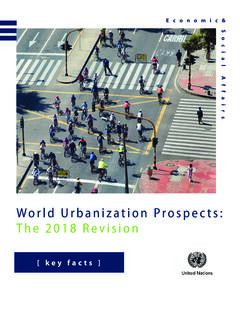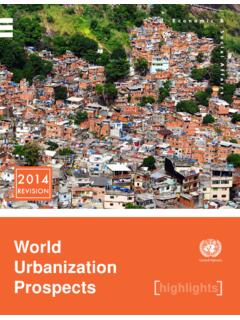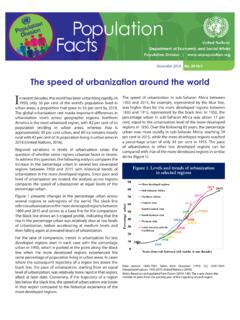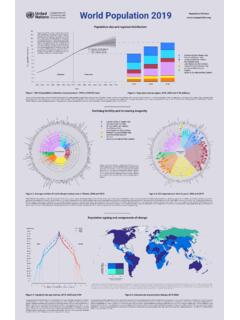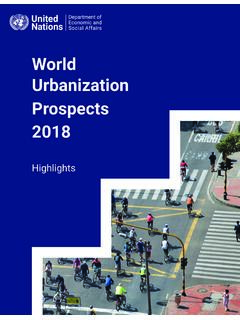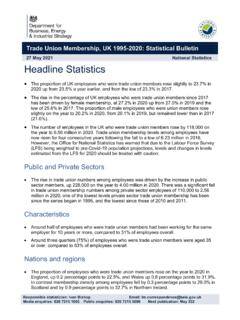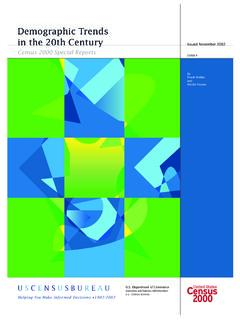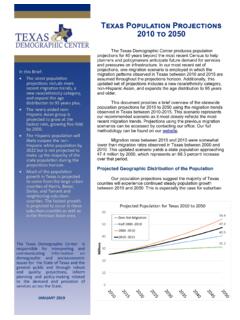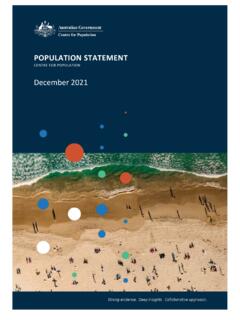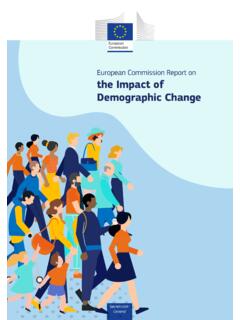Transcription of World Urbanization Prospects - Un
1 WorldUrbanizationProspectsThe 2018 Revision This page is intentionally left blank ST/ Department of Economic and Social Affairs population Division World Urbanization Prospects The 2018 Revision United Nations New York, 2019 The Department of Economic and Social Affairs of the United Nations Secretariat is a vital interface between global policies in the economic, social and environmental spheres and national action. The Department works in three main interlinked areas: (i) it compiles, generates and analyses a wide range of economic, social and environmental data and information on which States Members of the United Nations draw to review common problems and take stock of policy options; (ii) it facilitates the negotiations of Member States in many intergovernmental bodies on joint courses of action to address ongoing or emerging global challenges.
2 And (iii) it advises interested Governments on the ways and means of translating policy frameworks developed in United Nations conferences and summits into programmes at the country level and, through technical assistance, helps build national capacities. The population Division of the Department of Economic and Social Affairs provides the international community with timely and accessible population data and analysis of population trends and development outcomes for all countries and areas of the World . To this end, the Division undertakes regular studies of population size and characteristics and of all three components of population change (fertility, mortality and migration).
3 Founded in 1946, the population Division provides substantive support on population and development issues to the United Nations General Assembly, the Economic and Social Council and the Commission on population and Development. It also leads or participates in various interagency coordination mechanisms of the United Nations system. The work of the Division also contributes to strengthening the capacity of Member States to monitor population trends and to address current and emerging population issues. Notes The designations employed in this report and the material presented in it do not imply the expression of any opinions whatsoever on the part of the Secretariat of the United Nations concerning the legal status of any country, territory, city or area or of its authorities, or concerning the delimitation of its frontiers or boundaries.
4 The term country as used in this report also refers, as appropriate, to territories or areas. This report is available in electronic format on the Division s website at For further information about this report, please contact the population Division, Department of Economic and Social Affairs, United Nations, Two United Nations Plaza, DC2-1950, New York, 10017, USA; phone: +1 212-963-3209; email: Suggested citation: United Nations, Department of Economic and Social Affairs, population Division (2019). World Urbanization Prospects : The 2018 Revision (ST/ ). New York: United Nations. Official symbols of United Nations documents are composed of capital letters combined with numbers, as illustrated in the above citation.
5 Cover photo credit: Bogot , Colombia, by Dominic Chavez/ World Bank, 2016, used under CC BY-NC-ND , cropped from original. Published by the United Nations Sales no.: ISBN: 978-92-1-148319-2 eISBN: 978-92-1-004314-4 Copyright 2019 by United Nations, made available under a Creative Commons license CC BY IGO: World Urbanization Prospects : The 2018 Revision iii United Nations Department of Economic and Social Affairs/ population Division PREFACE This report presents the results of the official United Nations estimates and projections of urban and rural populations for 233 countries and areas of the World and for close to 1,900 urban settlements with 300,000 inhabitants or more in 2018, as published in World Urbanization Prospects : The 2018 Revision.
6 The data in this revision are consistent with the total populations estimated and projected according to the medium variant of the 2017 Revision of the United Nations global population estimates and projections, published in World population Prospects : The 2017 Revision. This revision updates and supersedes previous estimates and projections published by the United Nations. Other products presenting the results of the 2018 Revision include a Highlights a methodological report,2 among others. In preparing the 2018 Revision, particular attention was given to the production of detailed documentation on the data sources and definitions used at the country level, as well as for cities and urban agglomerations.
7 The full metadata compiled in this regard are accessible on the population Division s The site also includes useful figures and maps illustrating the results obtained. Responsibility for the 2018 Revision rests with the population Division. In preparing the 2018 revision, the population Division relied on the collaboration of the Statistics Division of the Department of Economic and Social Affairs of the United Nations Secretariat; its United Nations demographic Yearbook and its accompanying databases have provided access to official national population statistics used in the preparation of the 2018 revision.
8 The population Division also acknowledges the use of information accessible via the website and the support of national statistical offices that made available data and reports from recent censuses and surveys. The population Division is grateful for the contributions made by all these entities. This report and/or the underlying datasets were prepared by a team led by Fran ois Pelletier, that included Lina Bassarsky, Danan Gu, Sara Hertog, Mun Sim Lai, Cheryl Sawyer, Thomas Spoorenberg and Guangyu Zhang. Igor Ribeiro contributed programming and data processing, and Neena Koshy provided formatting and editorial support.
9 Frank Swiaczny provided comments and inputs on the draft report. This publication is accessible on the website of the population Division at For further information about the 2018 Revision, please contact the population Division, Department of Economic and Social Affairs, United Nations, Two United Nations Plaza, DC2-1950, New York, NY 10017, USA; tel.: +1 212-963-3209; email: 1 United Nations (2019). World Urbanization Prospects 2018: Highlights (ST/ ). 2 United Nations (2018a). World Urbanization Prospects : The 2018 Revision, Methodology.
10 Working Paper No. ESA/ 3 This page is intentionally left blank World Urbanization Prospects : The 2018 Revision v United Nations Department of Economic and Social Affairs/ population Division CONTENTS PREFACE .. iii EXPLANATORY NOTES .. viii CLASSIFICATION OF COUNTRIES BY GEOGRAPHIC REGION, INCOME GROUP AND GEOGRAPHIC SUBREGION OF THE World .. x EXECUTIVE SUMMARY .. xix INTRODUCTION AND POLICY IMPLICATIONS .. 1 A. Urbanization and sustainable development .. 3 B. Data and methods .. 5 I. URBAN AND RURAL population GROWTH AND World Urbanization Prospects .. 9 A. Overview of World Urbanization trends .. 9 B. Contrasting Urbanization trends in the less developed regions and the more developed regions.

